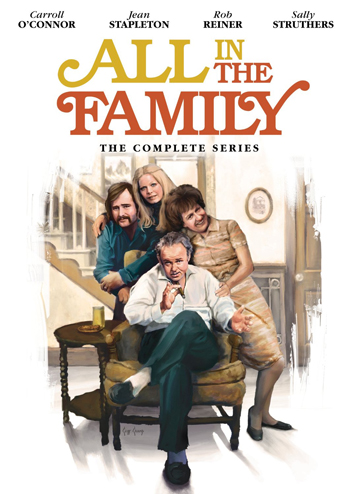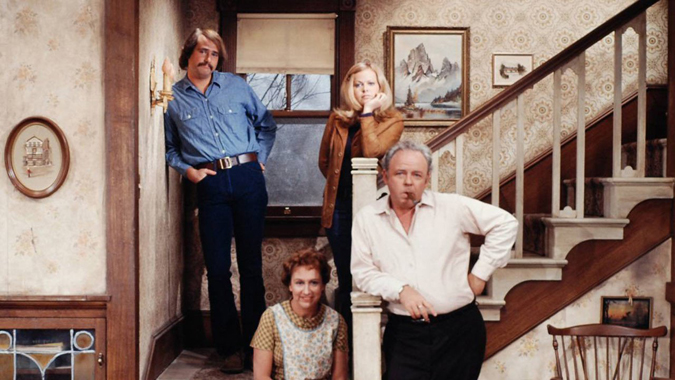Note: Jim Plath provides his thoughts on All in the Family while William Lee provides some brief words and a write-up of the video, audio, extras, and film value.
Didn’t need o welfare state.
Everybody pulled his weight.
Gee, our old LaSalle ran great.
Those were the days…
All in the Family according to Jim:
Not too many years ago I visited the Smithsonian in Washington, D.C. and was amazed at the contents of “America’s attic.” Look here and you see the original Star-Spangled Banner. Look there, and behold, the actual tent that George Washington used at Valley Forge, or a taxidermy mount of a famous Confederate general’s horse. Amid all the historical relics are a few pop-cultural ones, including Fonzie’s leather jacket from Happy Days, and Archie Bunker’s chair from All in the Family. Archie’s chair? Heyyyyy!
Who would have thought that a Norman Lear version of a British comedy, Till Death Us Do Part, a show introduced to the American public with a warning label that the contents were offensive, would have such an impact as to be commemorated now in the national museum?
When the show debuted on CBS that January 12, 1971, America was just as divided as it is now, embroiled in debates over a war (Vietnam, not Iraq) and social programs (Civil Rights and Women’s Rights, not Gay and Lesbian Rights). Conservatives like Archie Bunker railed against welfare, Head Start, Affirmative Action, women’s lib, anti-war protesters, hippies, and “foreigners”—anyone who didn’t fit the profile of white America. Archie Bunker became a lightning rod for sensitive issues, a way of waving them in the face of the public like the flag and saying the unspeakable. These were things people were uncomfortable talking about at the water cooler or outside classrooms, but All in the Family found a home with Americans because it played to both sides. Archconservatives found a kindred spirit in Archie and cheered him for saying what they could only think, while liberals pointed to the load of “bunk” that Bunker delivered in his monologic rants. He was the poster child for what was wrong with America, and he was the poster child for the average American. For five years—the first years of the show when All in the Family topped the Nielsen’s—it was a marriage made in TV heaven.
Like The Honeymooners, it was a minimalist set, with mostly the combined living room and dining room of the Bunkers shown, and occasionally the kitchen and front “stoop” (porch). Now and then viewers would see the bar where Bunker escaped, or a bureaucratic office he had to go to, but we rarely saw him on the loading dock where he made his blue-collar living. Most of his co-workers and neighbors came to the house when they made their appearances. But inside that minimalist set, fireworks went off on a weekly basis. In retrospect, if Seinfeld was a show about nothing, All in the Family was a show about everything. And shouting. Every show was built around a central issue up for debate, and Archie (Carroll O’Connor) would rant while his daughter, Gloria (Sally Struthers), and live-in son-in-law, Mike Stivic (Rob Reiner) would rail against the establishment. Meek Edith (Jean Stapleton), meanwhile, could see both sides and tried to keep the peace. Mike, a jobless college student, in addition to being Polish, was Archie’s in-house target, but also his nemesis; because if Archie was the quintessential archconservative, Mike was the kind of liberal that Rush Limbaugh would attack years later. And there was a lot of name-calling.
All in the Family according to Will:
It may have been nice if the producers had decided to let All in the Family go out on top in terms of quality. The ratings may have dipped by the ninth season, but it was the series was still in the Nielsen’s top 10. All in the Family also continued to be a strong presence at the Emmys and Golden Globes with numerous wins and nominations. However, what was once cutting edge became strained with the hard-nosed Archie transforming into a gruff teddy bear. Family became a very different show towards the end when Mike and Gloria moved to California at the end of season 8. The producers decided to shake things up by falling into clichés by introducing Stephanie (Danielle Brisebois), the cute 9-year old daughter of Edith’s cousin Floyd. Abandoned on their doorstep, Archie and Edith took her and loved her like she was their own. After that, Family became Archie Bunker’s Place, which ran for four seasons. All in the Family was also the source of two other successful spin-offs, Maude with Bea Arthur as Edith’s strong willed cousin, and most famously, The Jeffersons, in which Archie’s neighbors move on up to a deluxe apartment on the Upper East Side.
Video/Audio: 7
The video is presented with an aspect ratio of 1.33:1. The transfers show a bit of age, which isn’t surprising considering this is a sitcom from the 70’s. Still, the DVDs are watchable with some faded colors and a tiny layer of grain. The episodes from later seasons look a bit crisper.
The audio is presented in Dolby Digital 2.0 mono. The sound is clear and clean.
Extras: 6
Sony initially released the first six seasons of All in the Family, before Shout took over and released the final three. Now, they’ve put together a complete collection inside a handsome hardbound case with a booklet containing photos, essays, and a detailed episode guide.
New Interview with Norman Lear (11:31) features the show’s creator discussing whether or not All in the Family could be made today, the network execs reaction to their controversial scripts, and the prevailing attitudes of the day.
Those Were the Days: The Birth of All in the Family (27:00) is an interview with Norman Lear as he talks about how his relationship with his own father inspired Archie Bunker, casting the actors, and the origins of various aspects of the show.
The Television Revolution Begins: All in the Family Is On the Air (30:40) features recent and vintage interviews with Lear and the cast as they discuss network and audience reactions to the series.
Both of the above mini-documentaries were previously available in the Norman Lear Collection.
Justice For All (35:03) is the original pilot shot in 1968 for the series when Archie was known as Archie Justice and it was to be titled Justice For All.
Those Were the Days (27:41) is a retooled version of the pilot shot in 1969 that’s a little closer to the All in the Family we know and love. It’s also a kick seeing completely different actors playing Mike and Gloria. Just goes to show how much Rob Reiner and Sally Struthers really added to the overall feel.
Gloria is the original pilot for a short-lived 1982 sitcom starring Sally Struthers as a recently divorced Gloria, who moves to the suburbs with her son Joey. She works as the assistant for a veterinarian played by Burgess Meredith.
Archie Bunker’s Place (47:35) is the debut episode of the spin-off series with Archie running his own bar and restaurant.
704 Hauser (24:35) is the first episode of another short-lived sitcom from 1994 with an introduction by Norman Lear. It starred John Amos as the liberal patriarch of an African-American family that has moved into the former home of Archie Bunker. He deals with a conservative son, who is dating a Jewish woman (Maura Tierney). A grown-up Joey Stivic pops in to provide some continuity.
Film Value: 8
While the look and fashion of All in the Family might be dated, the themes and dialogue are as relevant as ever. Sure, some of the phrasing might be different, but the characters’ discussions of race relations, the economy, and politics feel as if they could take place today, especially during this election year. All in the Family is a timeless classic and this complete series boxset is the perfect addition to any fan’s collection.




